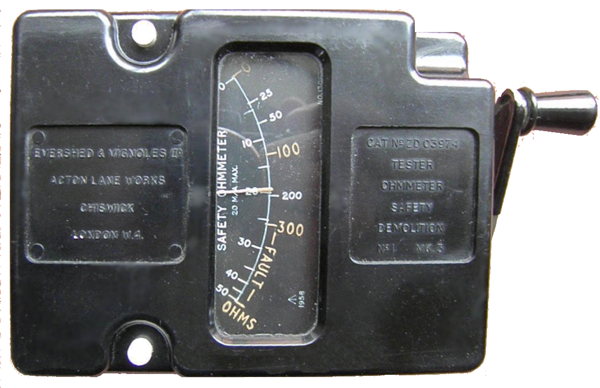

Evershed & Vignoles Safety Ohmmeter 12mA patent 400728 faulty
The Safety Ohmmeter for testing detonator circuits was introduced by E&V in 1946. It is similar in may respects to the series 3 " Megger " shown elsewhere on this site but has a range from zero to 50 ohms and is specially designed to have an output limited to 12 milliamps.The crank on the end powers a DC generator connected to a specially-designed meter. GB patent number 400728 was granted in 1933 and is present on many instruments made by this firm. Connections are made by depressing the spring loaded white buttons and slipping the bare end of the connecting wires into the holes on the sides.
Colin Ferrier who was an aircraft electrical fitter in the RAF has told me that the safety ohmmeter was used to check resistance of electrical detonators that fitted into hollow bolts (explosive bolts) that held the pilots canopy and navigators hatch of the Canberra aircraft in place. In the event of ejection these detonators would cause the bolts to explode thus allowing both canopy and hatch to be taken away by the slipstream allowing pilot and navigator(s) to eject safely. Aircraft fitted with auxiliary fuel tanks(tip tanks) also used explosive detonators.
Jes Flynn says that from the late 1960's the Fairey Mk 4 Safety Ohmmeter and upwards was the standard. He had never seen or heard of, never mind used a 'windy-up' one. He was an armament technician apprentice (actually the people who fitted and tested the Canberra dets not electricians!) He goes on to say that he fitted thousands of them.
The Canberra came into service in 1951 and the type of safety ohmmeter shown here was was procured and used by the services at least until 1958. The earliest reference I have found to the Fairey instrument [which works on a completely different principle] is dated 1957.

Internal view showing the low voltage DC generator which has a single pole rotor marked R125.3 which I assume is its resistance. The two fixed resistors are each approximately 3.5 ohms.

This view shows the meter movement. The lower hairspring was open circuit when I acquired the meter, it had apparently acted as a fuse when at some time it had presumably been connected across a live circuit. I have soldered a very fine piece of wire in its place and now the meter will give an indication of sorts. I noted that one coil is 5 ohms and the other is 7 ohms so I guess that the one in series with the hairspring that vapourised has a shorted turn or two!
Another military design dating from 1956:

How does it work? see here.
Evershed & Vignoles Ltd, Acton Lane Works,Chiswick. were taken over by AVO Ltd. Avocet House, 92-96 Vauxhall Bridge Road, London, SW1. AVO was a member of the Metal Industries Group of companies. Though known for their Avometer general purpose multimeter (see below), they made a wide range of test gear including valve testers. The Acton Lane works closed down at about that time - around 1986. The current range of products can bee seen at: https://uk.megger.com
The firm Megger Ltd is now based at: Archcliffe Road, Dover, Kent, CT17 9EN, United Kingdom.

